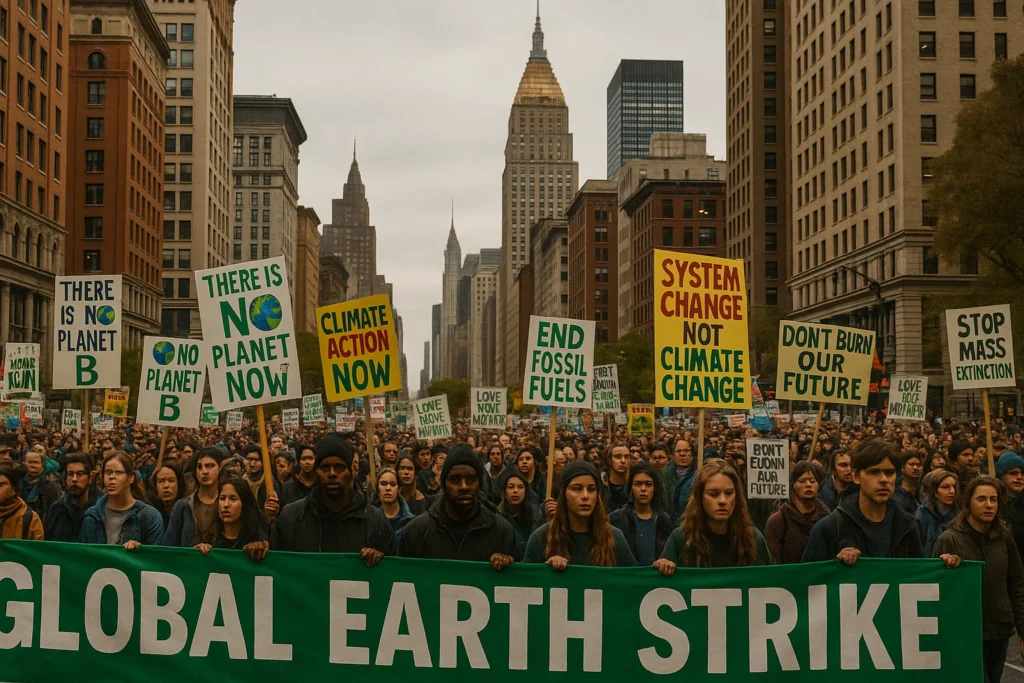In April 2025, climate activists made global headlines—from dyeing London’s Tower Bridge orange to mass marches in New York. But as groups like Just Stop Oil and Youth Demand escalate tactics, a critical question emerges: Do disruptive protests help or hurt the climate movement?
This article examines:
✔ Key climate protests of 2025
✔ The debate over radical vs. peaceful activism
✔ Public opinion on environmental demonstrations
✔ What’s next for the climate justice movement
Key Takeaways
🌍 April 2025 saw record protests in 12+ countries ahead of COP30
✊ Youth Demand activists arrested after paint protest at London Marathon
⚖️ Legal backlash grows—UK’s new protest laws impose harsher penalties
📉 Public support splits: 52% back goals but 61% oppose disruptive methods (YouGov)
🔄 Activists adapt: More “artistic” protests to avoid alienating supporters
Major Climate Protests of 2025
1. Tower Bridge Paint Protest (London)
- Who: Youth Demand (UK splinter group of Just Stop Oil)
- Action: Threw orange powder paint during marathon
- Result: 2 arrests, bridge closed for 3 hours
- Statement: “We’re coloring the truth—our leaders are failing us.”
2. Global “Earth Strike” Marches
| City | Attendance | Key Demand |
|---|---|---|
| New York | 80,000 | End fossil fuel subsidies |
| Berlin | 65,000 | 100% renewable energy by 2030 |
| Nairobi | 12,000 | Climate debt payments from Global North |

3. “Die-Ins” at Auto Shows
- Targeted: Electric vehicle expos in Detroit and Paris
- Irony?: Protesters say “EVs aren’t enough—we need systemic change.”
The Tactics Debate: Disruption vs. Diplomacy
Protest Methods Compared
| Tactic | Example | Public Reaction |
|---|---|---|
| Road blockades | Just Stop Oil (2023) | 72% negative (Ipsos) |
| Artistic displays | Red sand at UK Parliament (2024) | 58% supportive |
| Legal marches | NYC Climate Week | 81% approval |
“You can’t bankrupt an oil company with a picket sign—but you can with lawsuits and stock divestment.” — Bill McKibben, 350.org
Why Radical Groups Escalate
- Media attention: Disruption gets 5x more coverage (Reuters Institute)
- Frustration: World on track for 2.7°C warming despite COP pledges
- Youth urgency: “We’ve protested politely for 30 years” (Greta Thunberg)

Government Crackdowns Worldwide
New Anti-Protest Laws (2023-2025)
- UK: 6-month jail for “locking on” to infrastructure
- Germany: Bans masks at demonstrations
- Australia: Fines up to $50,000 for “economic disruption”
Controversy: UN warns laws may violate human rights to assembly.
What’s Next for Climate Activism?
1. Shift to “Positive Disruption”
- Example: Climate concerts with Billie Eilish
- Goal: Engage rather than alienate
2. Legal Strategies Gain Ground
- Shell lawsuit (Netherlands orders 45% emissions cut)
- Exxon shareholder activism
3. Focus on Local Wins
- Blocking new coal mines vs. global demands
- Community solar projects
Conclusion
As climate protests grow bolder in 2025, the movement faces a pivotal choice: double down on disruption or build broader coalitions. One thing is clear—with record heatwaves and rising sea levels, activists won’t stand down quietly.
Your turn: Where do you draw the line—necessary wake-up call or counterproductive stunt?
FAQs About Climate Protests
1. Do disruptive protests actually work?
Mixed evidence. Extinction Rebellion spurred UK climate declarations, but lost public support.
2. What’s Youth Demand’s goal?
UK-specific: End new oil/gas licenses immediately.
3. How can I support climate action without protesting?
- Divest from fossil fuels
- Join Citizens’ Climate Lobby (lobbying)
- Install community solar
4. Are activists mostly young?
Core members are under 35, but movements like Third Act mobilize retirees.
🎥 YouTube Video:
External Links for Further Reading
This guide unpacks the complex realities of modern climate activism—beyond the headlines. 🌎✊



